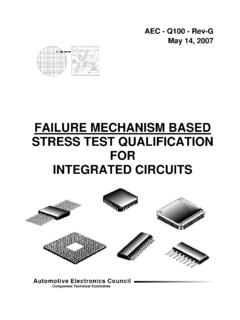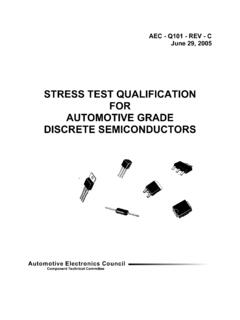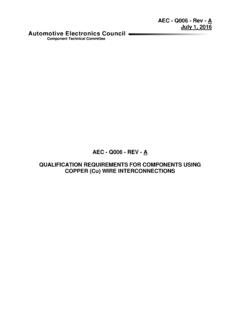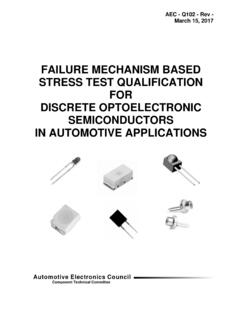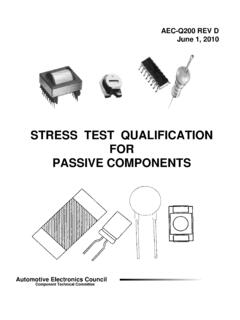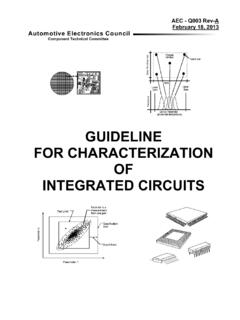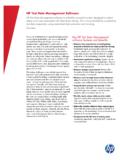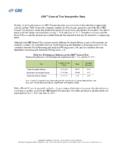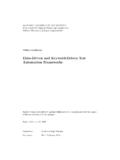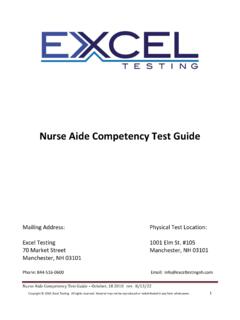Transcription of AEC - Q100-005 - REV-D1 January 9, 2012 Automotive ...
1 AEC - Q100-005 - REV-D1 January 9, 2012 Component Technical CommitteeAutomotive Electronics Council ATTACHMENT 5 AEC - Q100-005 - REV-D1 NON-VOLATILE MEMORY PROGRAM/ERASE ENDURANCE, DATA RETENTION, AND OPERATING LIFE TEST AEC - Q100-005 - REV-D1 January 9, 2012 Component Technical CommitteeAutomotive Electronics Council Acknowledgment Any document involving a complex technology brings together experience and skills from many sources. The Automotive Electronics Council would especially like to recognize the following significant contributors to the revision of this document: Sub-Committee Members: Friedrich Leisenberger AustriaMicrosystems Heinz Reiter AustriaMicrosystems Gregor Schatzberger AustriaMicrosystems Ramon Aziz Delphi Corporation Paul Hay Delphi Corporation Nick Lycoudes Freescale Peter Kuhn Freescale Suhail Mohammed Freescale Werner Kanert Infineon Georg Tempel Infineon Bill Meyer Lattice Semiconductor Mike Buzinski Microchip Bob Knoell NXP Semiconductors Mark Gabrielle ON Semiconductor Peter Cosmin ON Semiconductor Francis Classe Spansion Meir Janai Spansion Colin Martin Texas Instruments Clyde Dunn Texas Instruments Thomas VanDamme TRW AEC - Q100-005 - REV-D1 January 9.
2 2012 Component Technical CommitteeAutomotive Electronics Council NOTICE AEC documents contain material that has been prepared, reviewed, and approved through the AEC Technical Committee. AEC documents are designed to serve the Automotive electronics industry through eliminating misunderstandings between manufacturers and purchasers, facilitating interchangeability and improvement of products, and assisting the purchaser in selecting and obtaining with minimum delay the proper product for use by those other than AEC members, whether the standard is to be used either domestically or internationally. AEC documents are adopted without regard to whether or not their adoption may involve patents or articles, materials, or processes.
3 By such action AEC does not assume any liability to any patent owner, nor does it assume any obligation whatever to parties adopting the AEC documents. The information included in AEC documents represents a sound approach to product specification and application, principally from the Automotive electronics system manufacturer viewpoint. No claims to be in Conformance with this document shall be made unless all requirements stated in the document are met. Inquiries, comments, and suggestions relative to the content of this AEC document should be addressed to the AEC Technical Committee on the link Published by the Automotive Electronics Council. This document may be downloaded free of charge, however AEC retains the copyright on this material.
4 By downloading this file, the individual agrees not to charge for or resell the resulting material. Printed in the All rights reserved Copyright 2012 by the Automotive Electronics Council. This document may be freely reprinted with this copyright notice. This document cannot be changed without approval from the AEC Technical Committee. AEC - Q100-005 - REV-D1 January 9, 2012 Component Technical CommitteeAutomotive Electronics Council Change Notification The following summary details the changes incorporated into AEC- Q100-005 REV-D1 : Section 1, Purpose: Added note addressing One-Time Program (OTP) Non-volatile memories. Section , Program/Erase Endurance Cycling Procedure: Added rules for Checkerboard/Inverse-Checkerboard cycling.
5 Section , Post-Cycled Low Temperature Data Retention (LTDR) Procedure: Added new subsection (c). Appendix B: Added new captions for Tables B1 and B2. Corrected Table values. AEC - Q100-005 - REV-D1 January 9, 2012 Component Technical CommitteeAutomotive Electronics Council Page 1 of 10 METHOD - 005 NON-VOLATILE MEMORY PROGRAM/ERASE ENDURANCE, DATA RETENTION, AND OPERATING LIFE TEST Text enhancements and differences made since the last revision of this document are shown as underlined text. 1. PURPOSE This test is intended to evaluate the ability of the memory array of a standalone Non-volatile Memory (NVM) integrated circuit or an integrated circuit with a Non-volatile Memory module (such as a microprocessor Flash Memory) to: sustain repeated data changes without failure (Program/Erase Endurance), retain data for the expected life of the Non-volatile Memory (Data Retention), and withstand constant temperature with an electrical bias applied (Operating Life).
6 Alternative procedures requested by the NVM supplier, including but not limited to program/erase cycle sequencing, data retention duration and temperature, and checksum testing on stand-alone NVM devices, must be approved by the user. For Program/Erase Endurance Cycling, a data change occurs when a stored "1" is changed to a "0", or when a stored "0" is changed to a "1 . Failure occurs when a write or erase event is not completed in less than the maximum specified time, or when the event completes but the data pattern within the memory array does not correspond to the intended data pattern. Data Retention is a measure of the ability of a memory cell in an NVM array to retain its charge state in the absence of applied external bias.
7 Data retention failure occurs when a memory cell loses or gains charge to the extent that it is no longer detected to be in its intended data state. A bit flip is defined as the failure of a bit to retain its data state after a program or erase operation. Three categories of failure can occur due to Operating Life stress. The Non-volatile Memory may exceed its parametric limits, it may no longer meet the device specification requirements, or it may fail to retain its intended data state. Note that OTP (One-Time Program) Non-volatile Memories are a special case and certain sections of this test method may not be applicable. The same may apply for memories serving as an integral part of a device s operation.
8 The supplier and user should mutually agree on testing to be performed for these special cases. 2. APPARATUS The apparatus required for this test shall consist of a controlled temperature chamber capable of maintaining the temperature conditions at or above the specified temperatures ( , 125 C -0/+5 C chamber tolerance). Sockets or other mounting means shall be provided within the chamber so that reliable electrical contact can be made to the device terminals in the specified circuit configuration. Power supplies and biasing networks shall be capable of maintaining the specified operating conditions throughout the test. Also, the test circuitry shall be designed so that the existence of abnormal or failed devices will not alter the specified conditions for other units on test.
9 Care shall be taken to avoid possible damage from transient voltage spikes or other conditions which might result in electrical, thermal or mechanical overstress. AEC - Q100-005 - REV-D1 January 9, 2012 Component Technical CommitteeAutomotive Electronics Council Page 2 of 10 3. PROCEDURE Devices containing NVM shall first be preconditioned (exercised) through the Program/Erase Endurance test before performing High Temperature Data Retention (HTDR), High Temperature Operating Life (HTOL) and Low Temperature Data Retention (LTDR) testing (see Figures 1 and 2): Figure 1: High Temperature Test Sequence for Devices Containing NVM Figure 2: Low Temperature Test Sequence for Devices Containing NVM Separate testing for high temperature and low temperature degradation processes is required since, while some degradation processes are accelerated by temperature, other degradation processes ( , Stress Induced Leakage Current (Flash-SILC)) heal with temperature and may not show up in the high temperature flow.
10 With user approval, the supplier is allowed to reduce the size of the NVM array being preconditioned or endurance tested to reduce qualification time to a reasonable length. In such instances the program/erase cycles applied to the reduced memory must be no less than the maximum specification. The size of the reduced memory array shall represent the amount typically used in high endurance applications. The remaining array segments shall be preconditioned or endurance tested to the maximum number of program/erase cycles possible without adding unreasonable qualification time. Program/erase cycling shall follow the requirements of this document outlined in Section Low Temperature Program/Erase Endurance Cycling per Section and Q100 Test B3 Low Temperature Data Retention Storage Life (LTDR) per Section High Temperature Data Retention (HTDR), per Section High Temperature Operating Life (HTOL), per Section and Q100 Test B1 High Temperature Program/Erase Endurance Cycling per Section and Q100 Test B3 AEC - Q100-005 - REV-D1 January 9, 2012 Component Technical CommitteeAutomotive Electronics Council Page 3 of 10 Program/Erase Endurance Cycling Procedure a.
